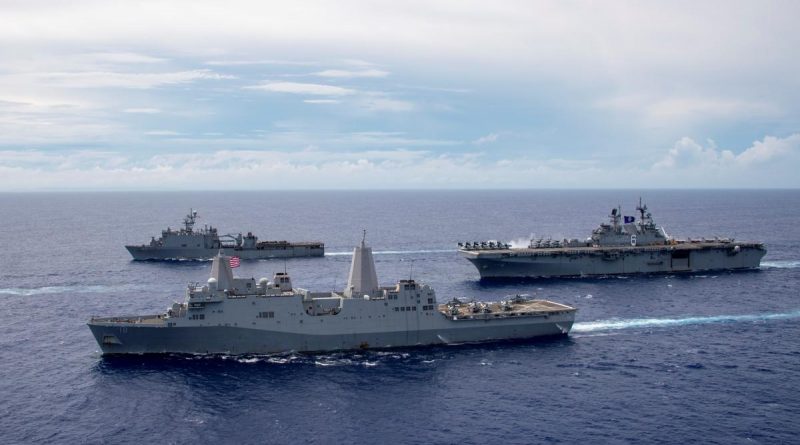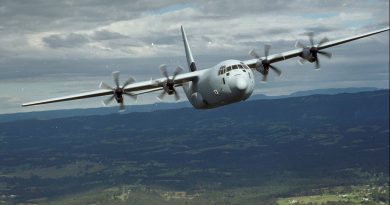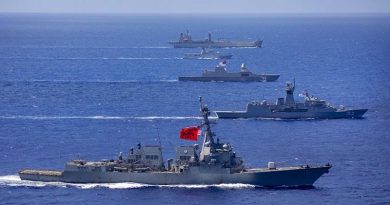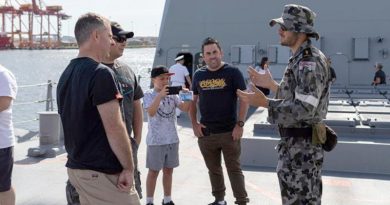Expeditionary Strike Group 7 arrives for Talisman Sabre
Share the post "Expeditionary Strike Group 7 arrives for Talisman Sabre"

The forward-deployed ships of Expeditionary Strike Group (ESG) 7, along with the 31st Marine Expeditionary Unit, arrived off the coast of Australia on July 16 in preparation for the biennial bilateral exercise Exercise Talisman Sabre 21 (TS21).
CAPTION: USS America, USS New Orleans and USS Germantown sail in formation in the Indo-Pacific region, heading to Talisman Sabre. Story by Lieutenant Commander Sherrie Flippin. Photo by Mass Communication Specialist 3rd Class Jomark Almazan.
Rear Admiral Chris Engdahl, commander of ESG 7 highlighted the clear need for, and benefits of exercises such as TS21.
“Emerging events in the Indo-Pacific region underscore the importance of presence to ensure a rules-based international maritime order,” Rear Admiral Engdahl said.
“Talisman Sabre allows the US, alongside partners and allies, to further enhance our ability to respond to any contingency as part of a joint or combined effort in support of a free and open Indo-Pacific region.”
The US maritime component of TS21 features the Navy’s only forward-deployed amphibious ready group (ARG), which includes the amphibious assault ship USS America (LHA 6), the amphibious transport dock ship USS New Orleans (LPD 18) and the amphibious dock landing ship USS Germantown (LSD 42), along with embarked elements of the Okinawa-based 31 MEU.
During TS21, the America ARG-MEU team will integrate with the Royal Australian Navy, Royal Canadian Navy, Japan Maritime Self Defense Force, and Republic of Korea Navy for maritime operations, further enhancing their ability to respond to crises as part of a joint or combined effort.
Partner nations will train together to operate and sustain each other in a contested maritime environment, conducting integrated amphibious and air defence operations, as well as tactical manoeuvrings and replenishments at sea.
At the heart of Talisman Sabre, the US-Australia alliance dates back more than 100 years, encompassing every modern world conflict since World War I.
Colonel Mike Nakonieczy, commanding officer of 31 MEU, said the value of maintaining and building trust with like-minded allies and partners was crucial to a free and open Indo-Pacific.
“The 31st Marine Expeditionary Unit and the America Expeditionary Strike Group have been a cohesive unit from the beginning of the deployment,” Col Mike Nakonieczy said.
“As we further our naval integration we also seek to build enduring, mutually beneficial relationships and invest in training with like-minded partners and allies throughout the region.”
Along with regional alliances and partnerships, the US Navy is also a steward of the marine environment wherever its ships operate, including the Great Barrier Reef.
Prior to Talisman Sabre, crews received training on environmental protective measures to minimise potential impact on marine life, which the Navy employs in accordance with the Marine Mammal Protection and Endangered Species Acts.
Australian environmental advisers have been integrated in every step of the Talisman Sabre planning process.
Likewise, mitigation for the continuing COVID-19 pandemic in partner nations has been a key component of Talisman Sabre planning.
US military forces continue to take appropriate force health protection measures, helping to mitigate the spread of COVID-19 while maintaining the commitment and capability to train and operate in this new environment.
.
.

.
.
Share the post "Expeditionary Strike Group 7 arrives for Talisman Sabre"





